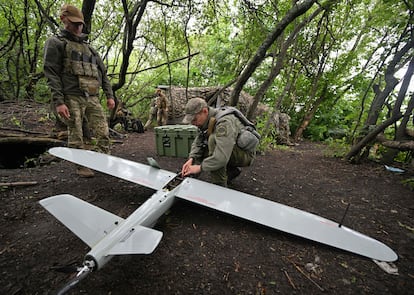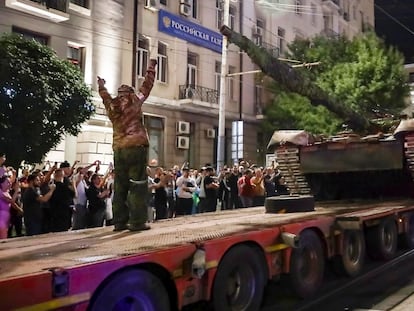Wagner rebellion changes the face of Russian front lines in Ukraine
Following the aborted uprising, it remains unclear where Prigozhin’s 20,000-25,000 mercenaries are deployed and what their next move will be after their leader’s exile

Amid the ongoing counteroffensive against Russian forces in the occupied zones, Kyiv sees the instability surrounding the Kremlin as an opportunity to continue its push to recover ground from the invader and to bolster the confidence of its allies, on whose arms and support it depends. With the removal from the battlefront of Wagner’s mercenary forces and the important role they played, according to military experts, nothing will be the same. At the same time, the sources consulted predict that in the short term there will be no substantial changes in the front line, where Wagner had no influence after having withdrawn from the key battle of Bakhmut. The mercenaries do, however, have a presence in other rear areas, with a deployment of between 20,000 and 25,000 personnel, according to different estimates. The long-term effects of Yevgeny Prigozhin’s aborted rebellion against Moscow are more difficult to gauge.
Wagner “had achieved important objectives, but, to a large extent, they have ended up destroying their reputation,” says a Ukrainian infantry colonel deployed in the east of the country since last year. Prigozhin said during the mutiny that he had 25,000 men at his disposal (Kyiv estimates that there are some 400,000 Russian troops inside its territory). Prigozhin’s figure is close to the 20,000 to 22,000 estimated by Vadim Denisenko, director of the Institute for the Future of Ukraine and, until January, advisor to the Interior Ministry. In Bakhmut alone, 20,000 Wagner soldiers lost their lives, according to Prigozhin’s own data. “About 100 died every day and another 300 were wounded. That’s 400 casualties a day, about 12,000 a month: It was impossible for him to keep up that pace,” Denisenko says. One of the main questions emerging after last Saturday’s rebellion is where Wagner’s forces are now. Several thousand crossed the border into Russia during the uprising in the city of Rostov-on-Don.
Wagner “obviously poses a threat” in the wake of the mutiny, says Vladislav Davidzon, a Ukrainian analyst at the Atlantic Council think tank. In fact, he believes that Prigozhin provided a lesson in what an uprising signifies to Russia’s stagnant power and military structures. Davidzon now predicts that half or two-thirds of those mercenaries will end up in Belarus, while others might be integrated into different Russian paramilitary companies. Only a few, he suspects, will agree to a contract with the regular military. “But how to trust that the army will not shoot them in the back or treat them badly? If I were them, I would not accept such a contract,” he states. The more professional and well-trained mercenaries could end up in Africa, where Wagner has been deployed for years providing numerous services in several countries, Denisenko adds.
Wagner’s mercenaries were first deployed in eastern Ukraine when the Donbas conflict broke out in 2014 and have been since been fighting and staging coups on behalf of Moscow in wars across Africa and the Middle East. “Wagner is among the best they have in Russia, and if they leave, so much the better,” says another Ukrainian serviceman who has been deployed on the eastern front for months and is now in the Kherson region in the south.
Will this crisis directly affect the ongoing Ukrainian counteroffensive? “Unfortunately for us, I don’t think so, and that’s a pity,” says Denisenko. He estimates that the scenario would be different if the mutiny had lasted a couple of weeks, but “it was a one-day coup.” Nor does the analyst see a turnaround in the counteroffensive “in the next few days” as likely. “There won’t be any major difference in the very short term. In the medium term, it will continue to eat away at the morale of the Russian army,” he predicts.
Pavlo Lakiychuk, a retired colonel who began his career in the former USSR’s Red Army, agrees. For him, it is significant that on a front like Bakhmut — from which Wagner has withdrawn, leaving regular troops to hold the line — the Ukrainian Army knows who it is facing. Lakiychuk explains that while the regular army is more measured in its actions and has more means at its disposal, Wagner’s men act in a more expeditious manner, with little regard as to the number of casualties.
The events of the last few days highlight “the weakness of the Russian state,” says Davidzon, who adds that the rebellion was “extremely good for the Ukrainians” because it sends a message to their NATO allies that victory can be achieved. However, despite the events of last Saturday raising expectations that Moscow’s spheres of power would crumble, “that moment did not really come,” adds the Atlantic Council analyst. “Many hoped for a miracle while enjoying the spectacle. But it was not so.”
Wagner’s reputation grew in the battle of Bakhmut, the bloodiest of the war so far for both sides. In late May, Prigozhin monopolized the announcement of victory in the city in the eastern region of Donetsk but at the same time he made plain his anger toward the Minister of Defense, Sergei Shoigu, stating that 20,000 of his men had lost their lives there. He also systematically accused Shoigu and Chief of the General Staff Valeri Gerasimov of leaving his troops without sufficient supplies and weapons.

Progress on all fronts
Due to these disputes and pressure on his men to sign contracts with the regular army, Prigozhin ordered the withdrawal of his troops to rearguard positions weeks ago. There, they were attacked by the Russian Army itself, according to Prigozhin. That was the trigger for the uprising from Rostov-on-Don, a Russian city close to the border with Ukraine. Although experts believe that there is no cause-effect relationship, coinciding with the open crisis in Russia, Kyiv announced on Monday that the counteroffensive was progressing on all fronts. Ukrainian President Volodymyr Zelenskiy himself visited troops on the frontline regions of Donetsk and Zaporizhzhia in celebration.
“Everything points to the fact that the role they [Wagner] have played so far is over,” the Ukrainian infantry colonel states. He believes that the breaking point between Prigozhin and the Kremlin was the attempt to bring the mercenaries into the fold of the Russian Army. In any case, “this is good news for Ukraine, because any kind of tension in our enemy’s territory has a strategically positive effect, causing disagreements and confusion. It will be interesting to see what happens now. It’s only a matter of time.”
Lakiychuk believes that Prigozhin’s popularity has risen many notches, surpassing Shoigu and Gerasimov. “Right now, Prigozhin has a good political mileage. There are many Russians who trust him,” Denisenko says, but he doesn’t see him suddenly rising to the top. “I think he is aware of all the risks he runs.” However, Denisenko does not believe “Putin is going to finish him off.” Prigozhin is now perceived as “an enemy and a traitor,” Davidzon notes, adding that last weekend he “came very close to being killed” before he closed the deal with Belarusian President Aleksander Lukashenko to halt Wagner’s advance toward Moscow.
The “problems of internal cohesion” that the crisis has brought to light in the Russian state and armed forces point to the fact that the beginning of the end of the war may have started, Davidzon opines. “Did you see the people on the street in Rostov treating Wagner members like heroes by bringing them water? That shows what the people in these places near the front line really think.”
Sign up for our weekly newsletter to get more English-language news coverage from EL PAÍS USA Edition
Tu suscripción se está usando en otro dispositivo
¿Quieres añadir otro usuario a tu suscripción?
Si continúas leyendo en este dispositivo, no se podrá leer en el otro.
FlechaTu suscripción se está usando en otro dispositivo y solo puedes acceder a EL PAÍS desde un dispositivo a la vez.
Si quieres compartir tu cuenta, cambia tu suscripción a la modalidad Premium, así podrás añadir otro usuario. Cada uno accederá con su propia cuenta de email, lo que os permitirá personalizar vuestra experiencia en EL PAÍS.
¿Tienes una suscripción de empresa? Accede aquí para contratar más cuentas.
En el caso de no saber quién está usando tu cuenta, te recomendamos cambiar tu contraseña aquí.
Si decides continuar compartiendo tu cuenta, este mensaje se mostrará en tu dispositivo y en el de la otra persona que está usando tu cuenta de forma indefinida, afectando a tu experiencia de lectura. Puedes consultar aquí los términos y condiciones de la suscripción digital.
More information
Archived In
Últimas noticias
Most viewed
- Reinhard Genzel, Nobel laureate in physics: ‘One-minute videos will never give you the truth’
- Oona Chaplin: ‘I told James Cameron that I was living in a treehouse and starting a permaculture project with a friend’
- Pablo Escobar’s hippos: A serious environmental problem, 40 years on
- Charles Dubouloz, mountaineering star, retires at 36 with a farewell tour inspired by Walter Bonatti
- Why we lost the habit of sleeping in two segments and how that changed our sense of time











































